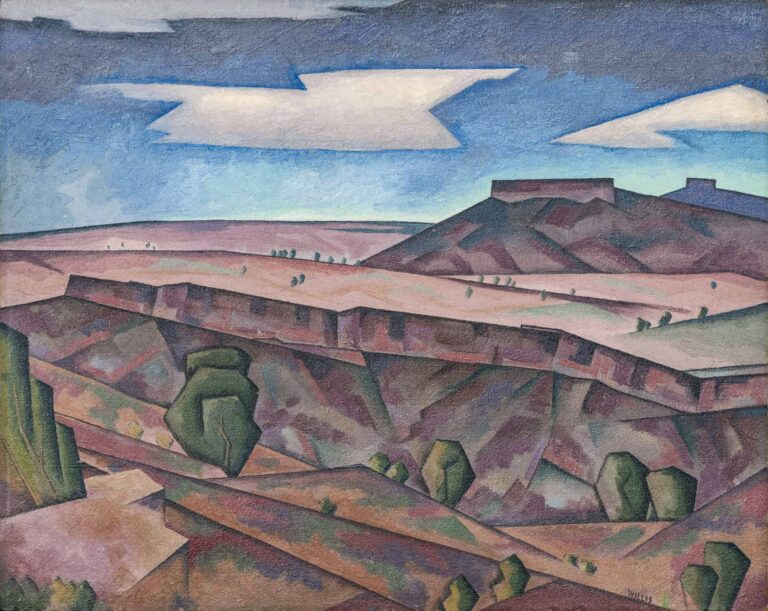Brooks Willis was unconventional in art and life. His name appeared as often in the Albuquerque society pages as his art appeared in local galleries and exhibits. He was known as a cutting-edge and outspoken “extreme modernist”1 painter who sketched from airplanes2 and included the occasional outhouse in his imagery.3 He had a reputation as a mover and shaker who both challenged and supported the art world establishment, and as an eligible—if reluctant—bachelor.4 He was also considered a war hero.
Though born in Farmington to a pioneering New Mexico family,5 Willis spent most of his early life and career outside of the state. He attended the Kansas City Art Institute in Kansas City, MO, and the Broadmoor Art Academy in Colorado Springs, CO. By the early 1930s, Willis had established himself in Albuquerque and was gaining recognition as an up-and-coming artist working in the “new style.”6 For two years, he consistently exhibited a variety of works, including lithographs, charcoals, and watercolors, with the same group of artists. By 1933, he was officially involved with the Albuquerque Society of Artists.7 In a move that was equal parts art market and social commentary—and which foreshadows his extensive involvement in federal art programs—he opened a show at Albuquerque’s Franciscan Hotel in November 1933 (at the height of the Great Depression) where he and a fellow artist traded paintings for “food or what have you.”8
The next five years of Willis’s career revolved around New Deal art projects. In the mid-1930s, he was commissioned by the Public Works of Art Project to paint easel paintings for public exhibition,9 an 8 x 13-foot mural depicting Albuquerque for the historic Bernalillo County Courthouse10 (sold to a private developer in 2020) and paintings for Albuquerque, Clayton, and Las Cruces schools. He was also engaged as a mural painter under the Federal Art Project and completed an eight-part series for Highlands University in Las Vegas, NM, in 1936. Willis was actively involved in the Albuquerque Little Theatre, a federal art project, as a set painter. He continued to promote Albuquerque’s art scene. He put on a groundbreaking “unsponsored” art show with two of his close colleagues11 and, at the same time, became active in the New Mexico Art League, chairing a discussion on the place of realism and abstraction in art.12
In summer 1939, Willis left Albuquerque to study in Europe. When World War II broke out, he joined a volunteer ambulance corps in France and later spent time in a German prison camp after the Nazi invasion. He was awarded the Croix de Guerre by the French government.
Willis returned home in late 1940 after eighteen months abroad. He immediately married, and in spring 1941 showed watercolors from his time at war. His career evolved as he took a faculty position with the University of New Mexico’s Art Department and then directed the University’s field school in Taos for two summer terms.
Army service and defense work prompted Willis to move his family to California in 1943, where he also worked for a time in Metro-Goldwyn-Mayer’s art department. Willis spent the next three decades in California before returning to Santa Fe to live out the remainder of his life.



